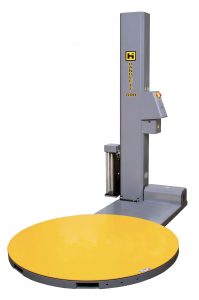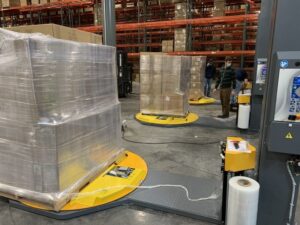How to Stretch Wrap a Pallet of Boxes [Pro’s Guide]
Whether your products travel by land, sea, or air, they run the very real risk of being damaged while in transit. Packaging Digest reports that anywhere from 2% to 11% of all shipments incur some form of damage by the time the products reach their final destination.
Shipping products is risky—vibration, impacts, and mishandling can cause costly damage. Using a semi- or fully-automatic pallet wrapping machine greatly improves protection compared to hand wrapping.
Read on to learn how to stretch wrap a pallet and keep your goods secure properly.

1. Assessment and Load the Pallet
- Avoid overloading. Do not exceed the pallet’s maximum weight or height capacity.
- Do not stack too high. Stacking products too high can create an unstable load that is hard to wrap and secure properly.
- Follow pallet wrapping guidelines. Adhere to the recommended maximum load weight and height to ensure a secure wrap.
- Check load stability. Before wrapping, calculate the pallet’s capacity to ensure the products’ total weight and height do not exceed the limits.
Use more stretch wrap for heavy or unstable loads. The more the products shift or lean, the more wrap you’ll need to secure them properly.
2. Initial Setup
1. Attach the film to the pallet.
- The best attachment point is in the lower corner of the pallet, further away from the carriage.
- Automatic pallet wrappers will perform this step automatically, so no need for workers to leave the forklift.
After you’ve attached the film, head over to the pallet wrapper control panel and make the following adjustments:
2. Revolution speed.
- Set the speed appropriately:
- Too fast may topple the load.
- Too slow will slow production.
- Find the right balance to secure the products without slowing down wrapping.
3. Carriage ascent and descent speeds
Assess the pallet height and weight. Then adjust the carriage ascent and descent speeds accordingly:
- For pallets over 6 feet tall: Set the speed slower to ensure thorough coverage. Going too fast can leave gaps.
- For heavier pallets: Set the speed slower to allow for more rotations at the top and bottom to secure the load properly.
- For lighter pallets: Set the speed faster to use fewer rotations for securing the load.
4. Optimize the wrapping speed
- Adjust the speed to use just enough wrap to secure the load without wasting excess.
- Monitor coverage and adjust speed as needed.
5. Film force tension
- Properly set the tension to avoid damage:
- Too tight can cause tearing or crush the bottom boxes.
- Too loose may not secure the load properly.
- Start with moderate tension, observe the results, and adjust based on load weight:
- Lighter loads: Use lighter tension.
- Heavier loads: Increase tension to secure the load properly.
*Note: Machines with the power pre-stretch feature tend to need less film force tension because it has memory. It will constrict back to the load after passing through the rollers.
6. Photo-eye delay setting
Understand the photo-eye delay function.
- The control setting causes the film to curl over the top of the load.
- For an A-load, aim for around 3-6 inches of overwrap to help secure the uppermost boxes on the pallet.
Assess the uniformity and weight of the pallet load.
- Determine whether the load is uniform or non-uniform, and whether it’s heavy or light.
Adjust the photo-eye delay setting:
- For uniform pallets with even sides: Use a shorter delay. The machine can easily detect the top and bottom, and the delay doesn’t need to be long.
- For non-uniform pallets with uneven sides: Use a longer delay to prevent the photo-eye from falsely detecting gaps at the top or bottom, which would cause it to stop wrapping too soon.
- For heavier pallets: Use a longer delay to allow for extra overwrap to secure the top boxes properly.
Test the settings.
- Watch the overwrap and adjust the delay until the proper overlap is achieved for the specific pallet.
3. How Much Is Too Much Stretch Wrap?
For a standard pallet of boxes under 2,000 pounds, set the top and bottom wrap settings to about three revolutions. This should be enough to secure lighter loads.
Indeed, there are situations where you need to apply more film, but be cautious not to waste time and money with too much stretch film.
4. Initial Test Wrapping
Perform an initial test wrap.
- Begin by wrapping the first pallet load.
- This may take a little longer initially, but it helps you determine the optimal wrapping speed for similar loads.
Start with slower speeds.
- Set both the turntable and carriage speeds slower at first.
- Gradually increase the speeds in small increments to find the optimal settings. This will help ensure a safe and secure wrap.
Set the film tension.
- Start with the tension set at about 50% as a baseline.
If the load includes fragile boxes, begin with the tension at around 20% to avoid damage. - Adjust the tension as you test and optimize for the specific load.
Optimize the cycle time.
- As you gain experience, you’ll develop a sense of the ideal cycle time, balancing speed and tension for a secure, efficient wrap.
5. Final Adjustments
Once the test wrap completes, pay particular attention to the bottom wraps to help secure the load to the pallet. Extra top wrap revolutions can also be helpful for unstable loads.
Finally, check the overall stability of the wrapped pallet. Does it seem stable and well-protected? If not, go back and adjust the stretch wrapper settings further. If so, cut the film and wrap it around the base of the pallet. The Model 1100 Series semi-automatic stretch wrap machine cuts and tucks the wrap into the base of the pallet automatically. Automating this final step saves time and allows the operator to remain on their forklift.
Watch the Model 850PS Wrap a Pallet
See how quick and easy it is to securely wrap a pallet with the Handle-It Model 850PS shrink-wrapping machine..
When wrapping a pallet of boxes with a pallet wrapper, several steps can be taken to ensure a successful and secure wrap. Read on to learn more about how to properly shrink-wrap a pallet and keep your goods safe and secure.
Stretch Wrapping Tips and Considerations
Taking the time to dial in a stretch wrapping machine properly pays off through securely wrapped pallets and damage-free shipping. Explore our answers to common questions and considerations when setting up your pallet wrapper.
How Much Stretch Wrap Do I Need to Wrap a Pallet?
- Consider the type of film.
- Pre-stretched film: Contains built-in tension and uses less material.
- Non-pre-stretched film: Requires more revolutions and wrap to create tension around the load.
- Evaluate the load.
- The weight, size, and consistency of the load will impact the amount of stretch wrap required.
- The weight, size, and consistency of the load will impact the amount of stretch wrap required.
- Understand the amount of film needed.
- For a typical 40×48 inch pallet stacked about 5 feet high:
- With non-pre-stretched film, you’ll need approximately 100-150 feet of wrap.
- With a pre-stretched carriage, you may only need 30-40 feet for the same size load.
- For a typical 40×48 inch pallet stacked about 5 feet high:
- Understand the impact of pre-stretching.
- Pre-stretching stretches the film as it’s applied, covering more area with fewer linear feet of wrap.
- This mechanism dramatically reduces the total wrap usage for the same coverage.
Should You Strap or Wrap a Pallet First?
You should strap pallets before stretch-wrapping them. Strapping first provides load stability and compression. Then you can apply the stretch wrap over the straps to seal and contain the pallet. Strapping before wrapping also helps optimize pallet integrity for shipping and handling.
How Many Times Should You Wrap a Pallet?
The number of wrap revolutions depends on the box size and weight. Uniform, lighter loads need 2-3 revolutions. Heavier or irregular loads require up to 4 revolutions to stabilize the pallet. Using more than 4 revolutions wastes film with little added benefit.
Generally speaking, avoid wrapping the same section more than 2-3 times. Instead, do 2-3 low wraps to stabilize the bottom, then 2-3 higher wraps to seal the top. Four total revolutions (2 down, two high) secure most pallets well without excessive wrap use.
Non-Standard Load Considerations
Adjust the photo-eye delay to ensure complete coverage when wrapping irregular-sized loads. Start with a longer delay to prevent an early cutoff at the top. Watch the wrap and refine the setting for a proper top overlay.
Use lighter tension settings initially on uneven loads to avoid wrap breaks. Progressively increase tension for a better hold without crushing the contents. For tall pallets, slow the carriage speed to cover the height fully. Thicker film or lighter tension prevents punctures from sharp edges.
Have Questions or Need Help?
Learning the correct way to use your wrapping machine will help ensure a safe and secure loading experience—and a happy customer. If you have any questions about wrapping your pallets or your current pallet wrapping machine isn’t up to par, contact us today to learn more about how Handle-It can help solve your toughest wrapping challenges.


